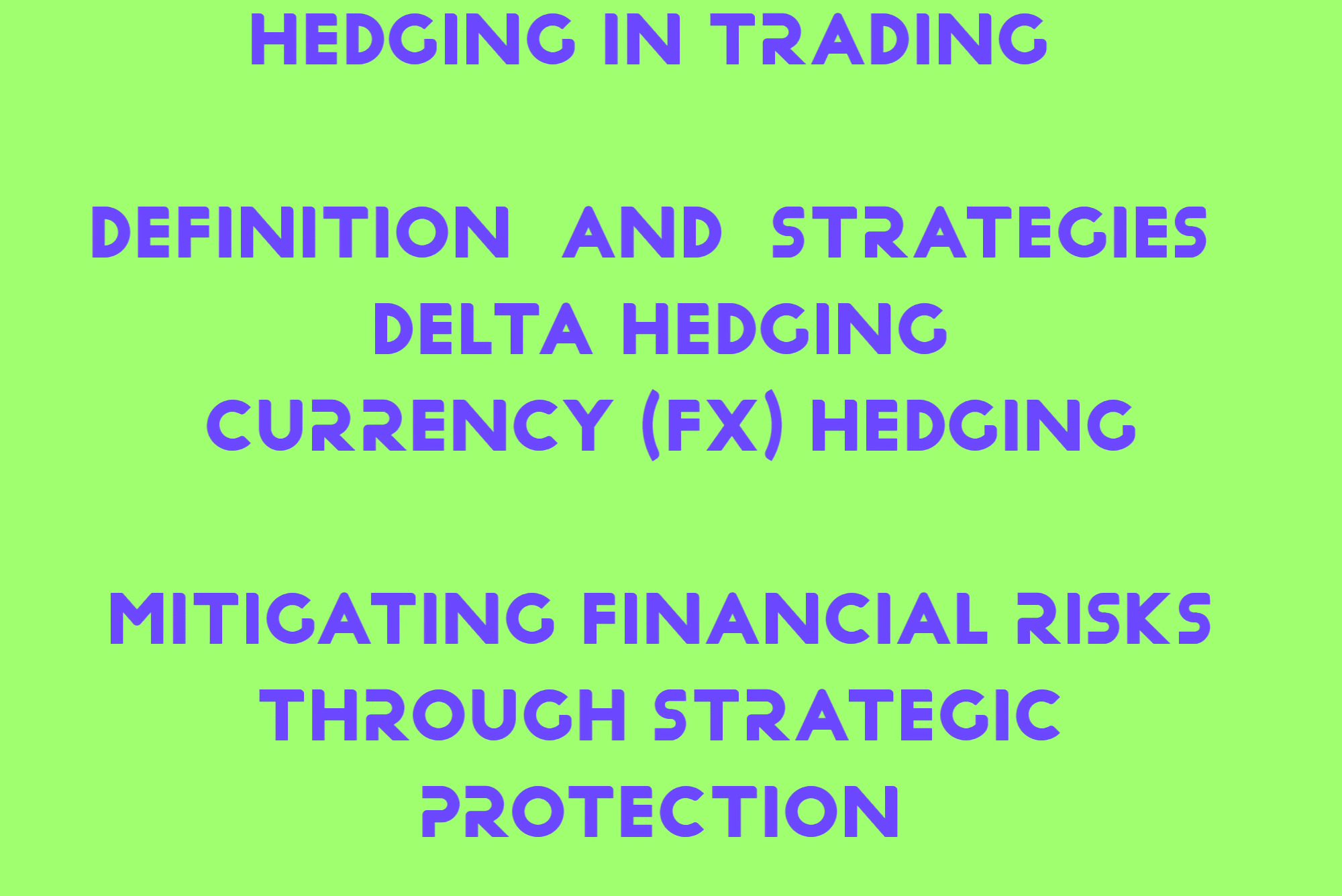Was ist Absicherung im Handel??
Unter Absicherung versteht man die Durchführung von Transaktionen mit dem Ziel, Vermögenswerte gegen finanzielle Risiken abzusichern und zu schützen.
Der Zweck von Absicherungsgeschäften besteht darin, den potenziellen Wertverlust von Vermögenswerten aufgrund ungünstiger Marktbedingungen zu minimieren oder auszugleichen. Durch die Absicherung können Sie einen bekannten Wert für potenzielle Verluste im Falle eines Rückgangs des Vermögenswerts ermitteln. Es gibt verschiedene Absicherungsstrategien.
Die beliebtesten sind die Verwendung von Derivaten – Futures und Optionen. Durch den Kauf eines realen Vermögenswerts und einer Put-Option auf denselben Vermögenswert zum aktuellen Preis, Ein Anleger schützt seine Anlage vor einem Rückgang des Vermögenswerts, indem er die Verluste auf die gezahlte Prämie begrenzt. Anbieter realer Rohstoffe nutzen Kombinationen aus Terminkontrakten und Optionen auf ähnliche Rohstoffe, um sich gegen Preisrisiken abzusichern.
Diversifikation ist eine Absicherungsstrategie, die auf der Bildung eines Anlageportfolios basiert. Bei dieser Strategie geht es darum, die Investitionen eines Anlegers auf verschiedene Vermögenswerte zu verteilen, Dabei werden häufig Kombinationen aus Aktien verschiedener Sektoren oder Aktien und Anleihen in bestimmten Verhältnissen verwendet. Der Kern dieser Strategie liegt darin, dass der Preis einer Komponente im Portfolio sinkt, die Preise anderer können steigen, Verluste auszugleichen.
Absicherungsbedeutung im Finanzwesen
Bei der Absicherung handelt es sich um eine Finanzstrategie, die darauf abzielt, potenzielle Risiken zu mindern und Vermögenswerte vor ungünstigen Marktbedingungen zu schützen. Dabei handelt es sich um die Durchführung von Transaktionen, die als Versicherungspolicen dienen, Sie tragen dazu bei, potenzielle Vermögenswertverluste zu minimieren oder auszugleichen. Durch den Einsatz von Absicherungstechniken, Anleger und Unternehmen können ihr Risiko gegenüber volatilen Marktschwankungen begrenzen und ein gewisses Maß an finanzieller Stabilität aufrechterhalten.
Eine der am häufigsten verwendeten Absicherungsmethoden ist der Einsatz von Derivaten, wie Futures und Optionen. Derivate sind Finanzinstrumente, deren Werte von einem zugrunde liegenden Vermögenswert abgeleitet werden. Sie bieten Anlegern die Möglichkeit, sich gegen potenzielle Verluste abzusichern, indem sie Verträge abschließen, die Schutz vor ungünstigen Preisbewegungen bieten.
Zum Beispiel, Ein Anleger, der einen realen Vermögenswert kauft und gleichzeitig eine Put-Option auf denselben Vermögenswert zum aktuellen Preis erwirbt, kann seine Investition vor einem Wertverlust des Vermögenswerts schützen. Wenn der Preis des Vermögenswerts tatsächlich sinkt, Der Verlust des Anlegers ist auf die für die Put-Option gezahlte Prämie begrenzt. Diese Strategie ermöglicht es Anlegern, ein vorgegebenes Risikoniveau festzulegen und sich vor ungünstigen Marktbedingungen zu schützen.
Im Bereich des Rohstoffhandels, Anbieter echter Rohstoffe nutzen häufig Kombinationen aus Terminkontrakten und Optionen, um sich gegen Preisrisiken abzusichern. Durch den Einsatz dieser derivativen Instrumente, Rohstoffproduzenten können sich vor möglichen Preisschwankungen des zugrunde liegenden Rohstoffs schützen. Dadurch können sie ein gewisses Maß an Preissicherheit schaffen und ihre Rentabilität sichern.
Eine weitere beliebte Absicherungsstrategie ist die Diversifikation, Dazu gehört die Erstellung eines Anlageportfolios, das sich über verschiedene Vermögenswerte erstreckt. Der Kern der Diversifizierung liegt in der Streuung der Investitionen auf verschiedene Sektoren, Anlageklassen, oder eine Kombination aus Aktien und Anleihen in einem bestimmten Verhältnis. Durch die Diversifizierung ihres Portfolios, Ziel der Anleger ist es, ihr Engagement in einer bestimmten Anlage zu reduzieren und potenzielle Verluste zu minimieren.
Das Konzept der Diversifikation besteht darin, dass der Preis einer Komponente im Portfolio fällt, die Preise anderer Vermögenswerte können steigen, helfen, die Verluste auszugleichen. Zum Beispiel, wenn ein Anleger Aktien verschiedener Unternehmen aus verschiedenen Branchen hält, Ein Wertverlust einer Aktie kann durch Gewinne bei anderen Aktien im Portfolio ausgeglichen werden. Durch Diversifizierung können Anleger ihr Gesamtrisiko reduzieren und sich vor der Volatilität einzelner Vermögenswerte schützen.
Es ist wichtig zu beachten, dass Absicherungsstrategien je nach den spezifischen Zielen variieren können, Risikotoleranz, und Anlagehorizont einzelner Anleger oder Unternehmen. Während Derivate und Diversifikation zwei häufig verwendete Methoden sind, Es stehen zahlreiche weitere Absicherungstechniken zur Verfügung, einschließlich Optionsstrategien, Terminkontrakte, und börsengehandelte Fonds (ETFs), unter anderem.
Abschließend, Die Absicherung spielt eine entscheidende Rolle beim Management finanzieller Risiken und beim Schutz von Vermögenswerten vor ungünstigen Marktbedingungen. Ob durch den Einsatz von Derivaten oder Diversifikationsstrategien, Anleger können potenzielle Verluste wirksam abmildern und ein gewisses Maß an finanzieller Stabilität aufrechterhalten. Durch den Einsatz dieser Absicherungstechniken, Privatpersonen und Unternehmen können mit größerer Zuversicht durch unsichere Marktumgebungen navigieren und ihre Investitionen schützen.
Absicherungsdefinition
Absicherungsstrategien
Finanzielle Risiken durch strategischen Schutz mindern
In der sich ständig verändernden Landschaft der Finanzmärkte, Anleger und Unternehmen sind einer Vielzahl von Risiken ausgesetzt, die sich auf den Wert ihrer Vermögenswerte auswirken können. In solch einem volatilen Umfeld, Das Konzept der Absicherung hat sich als strategisches Instrument zum Schutz vor potenziellen Verlusten und zur Gewährleistung eines gewissen Versicherungsniveaus herausgebildet. Bei der Absicherung handelt es sich um die Durchführung von Transaktionen, die darauf abzielen, den wahrscheinlichen Wertverlust von Vermögenswerten aufgrund ungünstiger Marktbedingungen zu minimieren oder auszugleichen. Es bietet Einzelpersonen und Organisationen die Möglichkeit, unsicheres Terrain mit mehr Selbstvertrauen und finanzieller Stabilität zu bewältigen.
Der Hauptzweck von Absicherungsgeschäften besteht darin, sich vor potenziellen Verlusten zu schützen und das Risiko ungünstiger Marktbewegungen zu begrenzen. Durch den Einsatz von Absicherungsstrategien, Anleger können die Höhe des potenziellen Verlusts auf einen bekannten Wert festlegen, Dadurch wird die Unsicherheit verringert und das Kapital geschont. Es stehen verschiedene Absicherungsstrategien zur Verfügung, Jedes ist darauf ausgelegt, spezifische Risiken zu berücksichtigen und unterschiedliche Anlageziele zu berücksichtigen.
Einer der am weitesten verbreiteten Absicherungsansätze ist der Einsatz von Derivaten, insbesondere Futures und Optionen. Derivate sind Finanzinstrumente, deren Werte von einem zugrunde liegenden Vermögenswert abgeleitet werden. Diese Instrumente bieten Anlegern die Möglichkeit, sich gegen potenzielle Verluste abzusichern, indem sie Verträge abschließen, die Schutz im Falle ungünstiger Preisbewegungen bieten.
Stellen Sie sich einen Investor vor, der einen realen Vermögenswert kauft und gleichzeitig eine Put-Option auf denselben Vermögenswert zum aktuellen Preis erwirbt. Dabei, Sie bilden einen Schutz gegen einen möglichen Wertverlust des Vermögenswerts. Wenn der Preis des Vermögenswerts tatsächlich sinkt, Der Verlust des Anlegers ist auf die für die Put-Option gezahlte Prämie begrenzt. Diese Absicherungsstrategie ermöglicht es Anlegern, ein vorgegebenes Risikoniveau festzulegen und sich vor ungünstigen Marktbedingungen zu schützen.
Anbieter realer Rohstoffe nutzen häufig auch Kombinationen aus Terminkontrakten und Optionen, um sich gegen Preisrisiken abzusichern. Durch den Einsatz dieser derivativen Instrumente, Rohstoffproduzenten können sich vor möglichen Preisschwankungen des zugrunde liegenden Rohstoffs schützen. Dadurch können sie ein gewisses Maß an Preissicherheit herstellen, Gewährleistung der Stabilität ihres Betriebs und Sicherung ihrer Rentabilität.
Eine weitere beliebte Absicherungsstrategie ist die Diversifikation, Dabei handelt es sich um die Erstellung eines Anlageportfolios aus verschiedenen Vermögenswerten. Diversifizierung zielt darauf ab, Investitionen auf verschiedene Sektoren zu verteilen, Anlageklassen, oder eine Kombination aus Aktien und Anleihen in bestimmten Anteilen. Das zugrunde liegende Prinzip der Diversifizierung besteht darin, das Engagement in einer bestimmten Anlage zu reduzieren und potenzielle Verluste zu begrenzen.
Durch Diversifizierung, wenn der Preis einer Komponente im Portfolio fällt, Gewinne aus anderen Vermögenswerten innerhalb des Portfolios können die Verluste ausgleichen. Zum Beispiel, Ein Anleger, der Aktien verschiedener Unternehmen aus verschiedenen Sektoren hält, kann einen Wertverlust einer Aktie verzeichnen. Jedoch, wenn andere Aktien im Portfolio an Wert gewinnen, Es trägt dazu bei, die entstandenen Verluste auszugleichen. Diversifikation fungiert als Risikomanagementinstrument, Dadurch können Anleger die Auswirkungen der Volatilität einzelner Vermögenswerte minimieren und sich vor konzentrierten Risiken schützen.
Es ist wichtig zu beachten, dass Absicherungsstrategien je nach individuellen Zielen variieren können, Risikotoleranz, und Anlagehorizont. Während Derivate und Diversifikation zwei häufig verwendete Methoden sind, Es gibt eine Vielzahl weiterer Absicherungstechniken. Dazu gehören Optionsstrategien, Terminkontrakte, börsengehandelte Fonds (ETFs), und mehr, jedes mit seinen eigenen Vorteilen und Überlegungen.
Abschließend, Absicherung spielt eine entscheidende Rolle beim Management finanzieller Risiken und beim Schutz von Vermögenswerten in einem dynamischen und unvorhersehbaren Marktumfeld. Ob durch den Einsatz von Derivaten oder Diversifikationsstrategien, Anleger können potenzielle Verluste wirksam abmildern und ein gewisses Maß an finanzieller Stabilität aufrechterhalten. Durch den Einsatz dieser Absicherungstechniken, Einzelpersonen und Unternehmen können turbulente Marktbedingungen mit größerer Zuversicht meistern und ihre Investitionen vor unvorhergesehenen Umständen schützen. Während sich die Finanzlandschaft weiterentwickelt, Die Bedeutung der Absicherung als strategisches Risikomanagementinstrument bleibt ungebrochen.

Delta-Absicherung
Risikomanagement durch dynamische Portfolioanpassungen
In der Welt der Finanzen, Das Risikomanagement ist ein entscheidender Aspekt erfolgreicher Investitionen. Eine Technik, die an Bedeutung gewonnen hat, ist das Delta-Hedging, Eine Strategie, die dazu dient, das Risiko von Preisschwankungen von Derivaten in Bezug auf ihre zugrunde liegenden Vermögenswerte zu mindern. Durch den Einsatz von Delta-Hedging, Anleger können Risiken effektiv verwalten und trotz Marktvolatilität ein ausgewogenes Portfolio aufrechterhalten. Ziel dieses Artikels ist es, ein umfassendes Verständnis der Delta-Absicherung und ihrer Anwendung im Risikomanagement zu vermitteln.
Delta, oft durch den griechischen Buchstaben Δ dargestellt, ist ein Maß für die Sensitivität des Optionspreises gegenüber Preisänderungen des zugrunde liegenden Vermögenswerts. Sie gibt an, in welchem Ausmaß sich der Preis der Option als Reaktion auf eine Änderung des Preises des Basiswerts ändert. Ein Delta von 1 bedeutet eine Eins-zu-Eins-Bewegung, Dabei steigt oder fällt der Optionspreis parallel zum Preis des Basiswerts. Ein Delta von 0.5 deutet darauf hin, dass sich der Optionspreis halb so stark bewegen wird wie der Preis des zugrunde liegenden Vermögenswerts.
Was ist Delta Absicherung?
Bei der Delta-Absicherung wird eine Position im Basiswert aufgebaut, die das Delta-Risiko des Derivats ausgleicht. Das Hauptziel besteht darin, ein Portfolio aufzubauen, in dem Wertänderungen der Option durch entsprechende Wertänderungen des zugrunde liegenden Vermögenswerts ausgeglichen werden, Dies führt zu einer risikoneutralen Position.
Um eine Delta-Absicherung durchzuführen, Ein Investor würde die folgenden Schritte unternehmen:
- Bestimmen Sie das Delta der Option: Der Deltawert der Option kann aus Preismodellen oder Handelsplattformen ermittelt werden. Es spiegelt die Sensitivität des Optionswerts gegenüber Änderungen des Preises des Basiswerts wider.
- Berechnen Sie die Anzahl der abzusichernden Optionen: Um die Delta-Exposition zu neutralisieren, Der Anleger muss die Anzahl der abzusichernden Optionen bestimmen. Dies erfolgt durch Division des Deltas der Option durch das Delta des Basiswerts. Zum Beispiel, wenn die Option ein Delta von hat 0.6 und der zugrunde liegende Vermögenswert hat ein Delta von 1, Der Anleger müsste sich durch Kauf oder Verkauf absichern 0.6 zugrunde liegende Vermögenswerte für jeden Optionskontrakt.
- Passen Sie das Portfolio an: Sobald die Anzahl der abzusichernden Optionen berechnet ist, Der Anleger nimmt die notwendigen Anpassungen an seinem Portfolio vor, indem er den Basiswert entsprechend kauft oder verkauft. Diese dynamische Anpassung stellt sicher, dass Änderungen im Wert der Option durch Änderungen im Wert des zugrunde liegenden Vermögenswerts ausgeglichen werden, das Delta-Risiko effektiv abzusichern.
Die Delta-Absicherung wird am häufigsten im Zusammenhang mit dem Optionshandel eingesetzt, wobei das Ziel darin besteht, das Delta-Risiko der Optionsposition zu neutralisieren. Durch dynamische Anpassung des Portfolios basierend auf Änderungen des Deltas, Anleger können eine risikoneutrale Position beibehalten und ihr Risiko gegenüber Preisschwankungen des Basiswerts verringern.
Die Wirksamkeit der Delta-Absicherung hängt von mehreren Faktoren ab, einschließlich der Genauigkeit der Delta-Schätzung, Transaktionskosten, Liquidität des Basiswerts, und die Zeitsensitivität der Optionen. Es ist wichtig zu beachten, dass die Delta-Absicherung keine narrensichere Strategie ist und möglicherweise nicht alle Risiken eliminiert. Jedoch, Es kann die Auswirkungen von Preisbewegungen erheblich reduzieren und für ein gewisses Maß an Stabilität in einem Portfolio sorgen.
Besonders relevant ist die Delta-Absicherung in Märkten mit hoher Volatilität oder beim Umgang mit komplexen Derivaten. Es ermöglicht Anlegern, ihr Risiko dynamisch zu steuern, Sie passen sich den veränderten Marktbedingungen an und stellen sicher, dass ihr Portfolio weiterhin ihrer Risikotoleranz und ihren Anlagezielen entspricht.
Abschließend, Delta-Hedging ist eine leistungsstarke Risikomanagementtechnik, die Anlegern hilft, die Unsicherheiten der Derivatemärkte zu meistern. Durch Ausgleich des Delta-Risikos von Optionen durch dynamische Anpassungen des Basiswerts, Anleger können eine risikoneutrale Position erreichen und die Auswirkungen von Preisbewegungen minimieren. Während die Delta-Absicherung eine sorgfältige Überwachung und Anpassung erfordert, Es bietet ein wirksames Mittel zum Risikomanagement und zur Aufrechterhaltung eines ausgewogenen Portfolios. Da Anleger weiterhin nach Strategien suchen, um ihre Investitionen zu schützen, Delta-Hedging bleibt ein wertvolles Instrument in ihrem Arsenal.
Grundlegendes Beispiel für eine Delta-Absicherung
| Position | Delta | Richtungsvoreingenommenheit | Erwarteter Gewinn/Verlust pro $1 Änderung des Aktienkurses |
|---|---|---|---|
| B | -3,000 | Bärisch | -$3,000 |
| Nach der Absicherung | -1,500 | Weniger pessimistisch | -$1,500 |
Erläuterung: Die Tabelle fasst die Informationen im Zusammenhang mit der Position und den Auswirkungen der Absicherung auf das direktionale Engagement zusammen.
- Position B hat zunächst ein Delta von -3,000, deutet auf eine bärische Tendenz hin. Das bedeutet, dass von der Position ein Gewinn erwartet wird $3,000 wenn der Aktienkurs fällt $1 und wird voraussichtlich verlieren $3,000 wenn der Aktienkurs um steigt $1.
- Um die Richtungsbelichtung der Position zu reduzieren, Der Händler beschließt, positive Delta-Strategien hinzuzufügen. Zur Absicherung entscheiden sie sich für den Kauf von Aktien.
- Um das Richtungsrisiko um zu verringern 50%, Der Händler berechnet, dass er kaufen muss 1,500 Aktien. Jede Aktie hat ein Delta von +1, was bedeutet kaufen 1,500 Aktien werden hinzugefügt 1,500 Deltas zur Position.
- Infolge, das neue Positionsdelta wird -1,500, Verringerung der bärischen Tendenz. Mit diesem angepassten Delta, Es wird erwartet, dass der Händler verliert $1,500 wenn der Aktienkurs um steigt $1. Dies stellt eine dar 50% Reduzierung des erwarteten Verlusts im Vergleich zum ursprünglichen -$3,000 Verlust pro $1 Anstieg des Aktienkurses.
Die Tabelle hilft dabei, die Auswirkungen der Absicherung auf das Richtungsrisiko der Position und den erwarteten Gewinn/Verlust pro zu visualisieren $1 Änderung des Aktienkurses.
Währungs- und FX-Absicherung
Schutz vor Wechselkursrisiken
In einer zunehmend globalisierten Welt, Unternehmen, Investoren, und Einzelpersonen sind den inhärenten Risiken ausgesetzt, die mit Devisen verbunden sind (FX) Schwankungen. Währungswerte werden von einer Vielzahl von Faktoren beeinflusst, einschließlich Wirtschaftsindikatoren, geopolitische Ereignisse, und Marktstimmung. Infolge, Der Bedarf an effektiven Währungs- und FX-Absicherungsstrategien ist von größter Bedeutung. Ziel dieses Artikels ist es, ein umfassendes Verständnis der Währungs- und FX-Absicherung zu vermitteln, ihre Bedeutung, und die verschiedenen Strategien zur Steuerung des FX-Risikos.
Die Währungsabsicherung ist ein proaktiver Ansatz, der von Einzelpersonen und Organisationen eingesetzt wird, um sich vor potenziellen Verlusten aufgrund ungünstiger Wechselkursschwankungen zu schützen. Ziel ist es, die Unsicherheit zu verringern und die Stabilität der Cashflows und Finanzprognosen aufrechtzuerhalten. Währungsabsicherungsstrategien sind besonders für Unternehmen im internationalen Handel von entscheidender Bedeutung, multinationale Konzerne, und Investoren mit Auslandsinvestitionen. Durch Absicherung des Währungsrisikos, Diese Unternehmen können ihre Gewinne sichern, Kosten, und Investitionen vor der Volatilität der Devisenmärkte.
Eine der gebräuchlichsten Methoden zur Währungsabsicherung ist der Einsatz von Termingeschäften. Terminkontrakte sind Vereinbarungen zwischen zwei Parteien, einen bestimmten Währungsbetrag zu einem vorher festgelegten zukünftigen Datum und Wechselkurs umzutauschen. Durch die Festlegung des Wechselkurses, Unternehmen können das Risiko ungünstiger Währungsschwankungen eliminieren. Dies sorgt für Sicherheit bei den Zahlungsströmen, schützt die Gewinnmargen, und erleichtert eine genaue Budgetierung und Finanzplanung.
Devisenoptionen sind ein weiteres beliebtes Instrument zur Währungsabsicherung. Währungsoptionen geben dem Inhaber das Recht, aber nicht die Verpflichtung, eine bestimmte Währungsmenge zu einem vorher festgelegten Preis innerhalb eines bestimmten Zeitraums zu kaufen oder zu verkaufen. Diese Optionen bieten Flexibilität und ermöglichen es Unternehmen und Anlegern, das Abwärtsrisiko zu begrenzen und gleichzeitig möglicherweise von günstigen Währungsbewegungen zu profitieren. Mit Devisenoptionen können sowohl erwartete als auch unerwartete Währungsschwankungen abgesichert werden, Bereitstellung eines wirksamen Mittels zum Risikomanagement.
Zusätzlich zu Terminkontrakten und Optionen, Währungsswaps werden häufig in FX-Absicherungsstrategien eingesetzt. Bei Währungsswaps handelt es sich um den Austausch von Kapital- und Zinszahlungen in unterschiedlichen Währungen zwischen zwei Parteien. Diese Vereinbarungen ermöglichen es den Gegenparteien, ihre Cashflows zu verwalten, Absicherung gegen Währungsrisiken, und Finanzierungskosten optimieren. Währungsswaps werden häufig von multinationalen Unternehmen eingesetzt, Finanzinstitute, und Investoren, die an grenzüberschreitenden Transaktionen beteiligt sind.
Zur Währungsabsicherung werden auch Terminkontrakte eingesetzt. Diese standardisierten Vereinbarungen zum Kauf oder Verkauf einer bestimmten Währungsmenge zu einem vorher festgelegten zukünftigen Datum und Preis werden an organisierten Börsen gehandelt. Terminkontrakte sorgen für Transparenz, Liquidität, und standardisierte Begriffe, Dies macht sie für Devisenhändler und Anleger attraktiv, die ihre Positionen absichern und das Währungsrisiko in ihren Portfolios verwalten möchten.
Strukturierte Produkte bieten einen maßgeschneiderten Ansatz zur Währungsabsicherung durch die Kombination verschiedener derivativer Instrumente. Diese Produkte sind auf die spezifischen Risikoprofile und Ziele von Unternehmen und Anlegern zugeschnitten. Strukturierte Produkte können Optionen beinhalten, vorwärts, tauscht, und andere Derivate, um umfassende FX-Risikomanagementlösungen bereitzustellen. Sie bieten Flexibilität bei der Gestaltung von Absicherungsstrategien und können so strukturiert werden, dass spezifische Risiken gemindert und gleichzeitig potenzielle Renditen optimiert werden.
Es ist wichtig zu verstehen, dass Währungs- und FX-Absicherungsstrategien das Währungsrisiko nicht vollständig beseitigen. Die Absicherung ist mit Kosten verbunden, wie Transaktionsgebühren und potenzielle Opportunitätskosten. Zusätzlich, Die genaue Vorhersage von Währungsbewegungen ist eine Herausforderung, und Absicherungsentscheidungen sollten auf einer gründlichen Analyse basieren, Risikobewertung, und Berücksichtigung der gewünschten finanziellen Ergebnisse.
Abschließend, Währungs- und FX-Absicherungsstrategien spielen eine entscheidende Rolle bei der Bewältigung der mit Wechselkursschwankungen verbundenen Risiken. Durch den Einsatz von Terminkontrakten, Währungsoptionen, Währungsswaps, Terminkontrakte, und strukturierte Produkte, Unternehmen, Investoren, und Einzelpersonen können sich wirksam vor ungünstigen Währungsschwankungen schützen. Durch die Umsetzung geeigneter Absicherungsstrategien, Sie können sich in der Komplexität des internationalen Handels zurechtfinden, Investition, und Finanzplanung mit mehr Sicherheit und Stabilität.

-
„Die Macht der Absicherung freisetzen: Strategien und Techniken zur finanziellen Absicherung“
-
„Absicherung 101: Ein umfassender Leitfaden zur Minderung finanzieller Risiken“
-
„Entdecken Sie die Vorteile der Absicherung: Schützen Sie Ihre Investitionen in unsicheren Zeiten“
-
„Absicherungsstrategien beherrschen: Ein tiefer Einblick in Derivate, Diversifikation, und mehr“
-
„Absicherung entmystifiziert: Die Kunst verstehen, Risiko und Chance in Einklang zu bringen“
-
„Aufbau einer soliden Finanzfestung: Wie Absicherung Ihr Vermögen schützen kann“
-
„Die Rolle der Absicherung in Anlageportfolios: Verbesserung der Stabilität und Leistung“
-
„Absicherungstechniken enthüllt: Einblicke in Optionen, Futures, und darüber hinaus“
-
„Finanzielle Widerstandsfähigkeit durch wirksame Absicherungsstrategien erreichen“
-
„Bewältigung der Marktvolatilität: Nutzen Sie die Kraft der Absicherung für langfristigen Erfolg“


